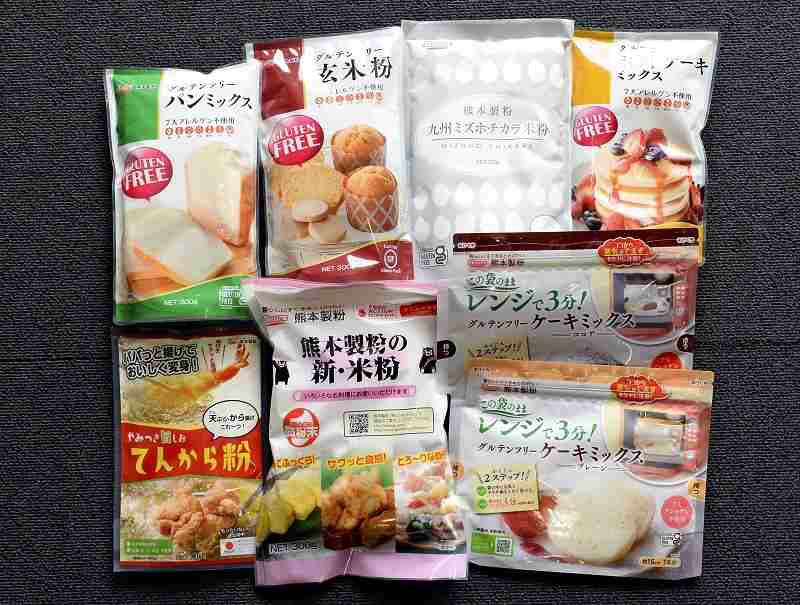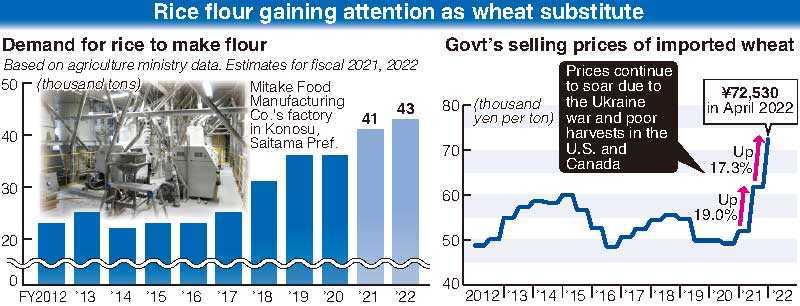
Bread made with rice flour is being sold at Hankyu bakery in the Kyoto Family shopping center in Ukyo Ward, Kyoto, on April 22.
2:00 JST, May 27, 2022
With imported wheat prices reaching record highs, the use of rice flour as a substitute has been gaining traction. Food made with rice flour, which is produced by finely milling grains of rice, might become a staple in the near future.
The thundering sound of rice being crushed into flour was deafening. At a mill, grains of rice travel through a pipe from the ceiling and are then crushed into flour. The finished product is then packaged, loaded onto trucks and shipped to various food manufacturers.
Mitake Food Manufacturing Co. produces rice flour at its factory in Konosu, Saitama Prefecture, using rice grown in the prefecture, such as the Sai no Kagayaki brand. The company also sells products made with rice flour, such as pancake mix, tempura powder and karaage powder, which is used to make fried foods.
Risako Suzuki, 40, manager of the company’s planning management office, said she had noticed a major change in March.
The company suddenly started receiving many inquiries from food manufacturers and supermarkets regarding substitutions for wheat flour and what can be made using rice flour.
This was around the time when the price for imported wheat was expected to increase following Russia’s invasion of Ukraine. As a result, rice flour became the ingredient of choice to replace wheat.
Bread made using rice flour has a unique chewy texture, and foods are crispier if it is lightly coated with the flour before being fried.
“Rice flour is generally stable in both supply and price, and it has the added value of being made in Japan,” Suzuki said. “We see the price increase for imported wheat as an opportunity.”

Rice flour-based products
Used for centuries
Rice flour has been used since the Nara period (710-784) to make dango dumplings, yokan sweet cakes and rice crackers. It has become more widely used in recent years as a result of advancing milling technology.
In March, NH Foods Ltd., more commonly known as Nipponham Group, began selling a pasta dish made with rice flour-based noodles called Minna no Shokutaku Neapolitan.
Koike-ya Inc. also renewed and released its snack food Okome Gokochi (Pure de Rice) series in March.
Pasco Shikishima Corp.’s Kokusan Komugi to Komeko no Roll, a roll made using a mixture of Japanese wheat and rice flours, has a unique chewy texture as a result of the rice flour.
Traditionally, the main ingredient for such foods is wheat flour. However, the price of wheat was increasing even before Russia’s invasion, mainly because of poor harvests in North America.
The government’s selling price of imported wheat for milling companies rose by 19.0% in October 2021 and then by 17.3% in April. The price of imported wheat has reached its second-highest level since 2007, when such comparisons became possible.
Many food manufacturers have been forced to raise their prices, but at the same time, there is an increasing interest in using rice flour as a substitute.

Downsides
Even though imported wheat prices are soaring, there are some disadvantages to using rice flour.
Grains of wheat are softer and can be easily crushed into powder. Rice, on the other hand, is much harder and needs to be soaked in water and then dried before it can be milled.
The annual demand for wheat in Japan exceeds 5 million tons, and only a few major millers produce wheat flour on a large scale. In contrast, the annual demand for rice to make rice flour is about 40,000 tons, and it is milled by small and midsize businesses nationwide.
According to the Agriculture, Forestry and Fisheries Ministry, it costs ¥60 to ¥300 to mill 1 kilogram of rice, compared with the ¥50 to ¥70 it costs to mill wheat, leading to higher retail prices.
Another issue is that it will likely take time for people to adjust to the taste and texture of rice flour in foods that have traditionally been made with wheat.
“The price hike of imported wheat provides a tailwind for rice flour, but it will only take hold if consumers find that it tastes good,” said an official of the agriculture ministry’s Cereal Crop Division.
There are still many hurdles to overcome before rice flour becomes a staple ingredient.
"Business" POPULAR ARTICLE
-

Tokyo Economic Security Forum to Hold Inaugural Meeting Amid Tense Global Environment
-

Keidanren Chairman Yoshinobu Tsutsui Visits Kashiwazaki-Kariwa Nuclear Power Plant; Inspects New Emergency Safety System
-

Imports of Rare Earths from China Facing Delays, May Be Caused by Deterioration of Japan-China Relations
-

University of Tokyo Professor Discusses Japanese Economic Security in Interview Ahead of Forum
-

Japan Pulls out of Vietnam Nuclear Project, Complicating Hanoi’s Power Plans
JN ACCESS RANKING
-

Tokyo Economic Security Forum to Hold Inaugural Meeting Amid Tense Global Environment
-

Keidanren Chairman Yoshinobu Tsutsui Visits Kashiwazaki-Kariwa Nuclear Power Plant; Inspects New Emergency Safety System
-

Imports of Rare Earths from China Facing Delays, May Be Caused by Deterioration of Japan-China Relations
-

University of Tokyo Professor Discusses Japanese Economic Security in Interview Ahead of Forum
-

Japan Pulls out of Vietnam Nuclear Project, Complicating Hanoi’s Power Plans
























